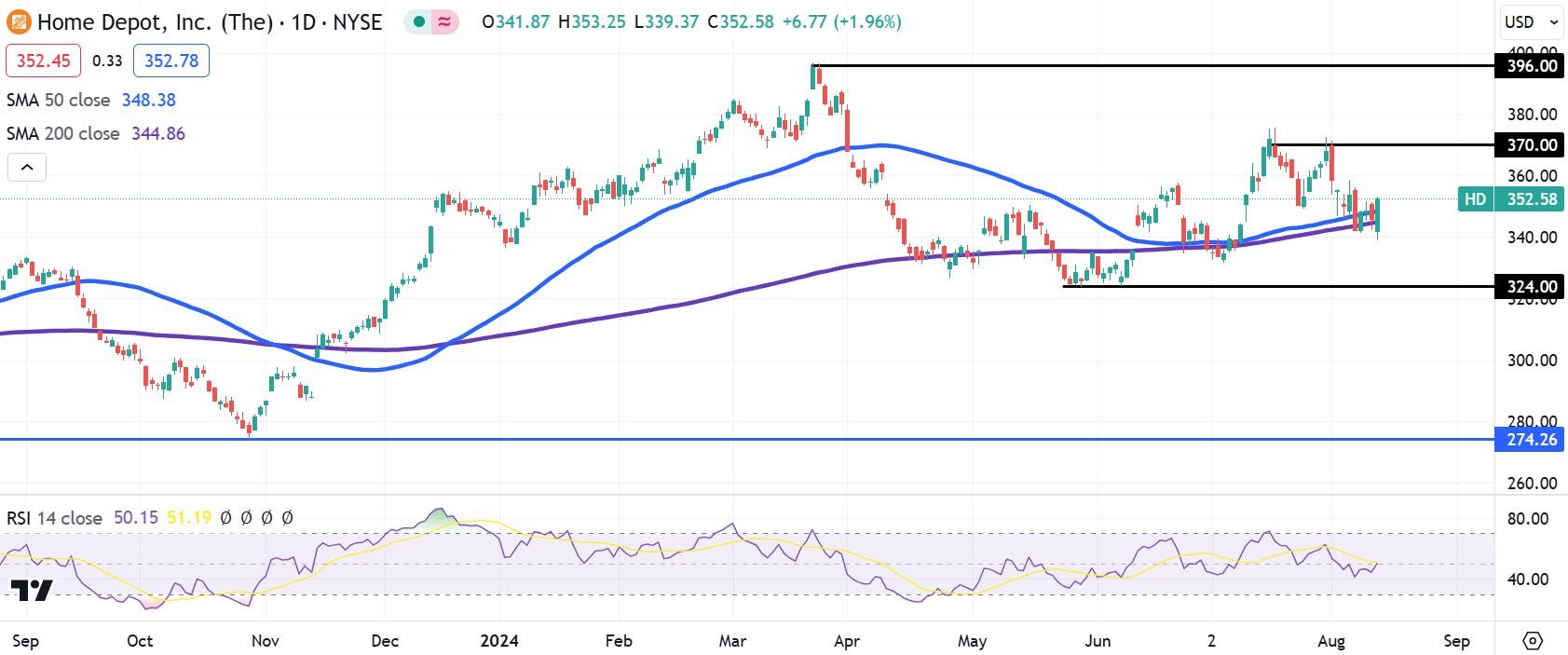- The Home Depot advances slightly after beating second-quarter expectations.
- Although retail spending is lagging, management projects an increase in annual sales.
- Markets are gaining after PPI inflation came in below consensus.
- Home Depot stock has plenty of nearby support that could help push it higher.
The Home Depot (HD) returned to normal on Tuesday after the previous quarter’s sales figure came in below the Wall Street consensus. This quarter, the second quarter, the home improvement retailer beat Wall Street’s forecast by nearly $500 billion in revenue and by 2.6% in adjusted profits.
Much of the market talk on Tuesday revolved around CEO Brian Niccol stepping down Chipotle Mexican Grill (CMG) in favor of Starbucks (SBUX)which sent Starbucks’ stock price soaring 22% while Chipotle’s shares fell in the opposite direction by 12%. In its shadow, Home Depot stock managed a decent gain of 1.7%.
In addition, other members of the Dow Jones such as Intel (INTC) and Nike (NKE) saw their stock prices rise following a lower reading of the Producer Price Index, leading the indexes higher as a rate cut by the Federal Reserve (Fed) in September now seems assured. At the time of writing, the Dow Jones is up 0.5%, while the S&P 500 is up 1.1% and the NASDAQ is up 1.8%.
The Home Depot earnings news
There was a scare in the premarket after The Home Depot management detailed its pessimistic view of the American consumer. High interest rates and inflation have taken a toll on American shoppers, and The Home Depot is seeing lower spending levels firsthand.
The retailer’s U.S. comparable sales fell 3.6% year over year in the second quarter compared with a consensus for a 2.4% drop. Customer transactions fell 1.8% during the quarter to $451 million, but were up more than 16% from the first quarter. The second quarter is typically the highest point for sales during the year. Average customer receipts also declined 1.3% to $88.90.
But the top and bottom lines saved the day. The Home Depot earned $4.67 in adjusted earnings per share (EPS), 12 cents above consensus. Revenue of $43.2 billion was only slightly above the year-ago figure, but came in $490 million above pessimistic expectations.
“The underlying long-term fundamentals supporting demand for home improvement are strong,” said CEO Ted Decker. “During the quarter, higher interest rates and heightened macroeconomic uncertainty pressured consumer demand more broadly, resulting in weaker spending on home improvement projects.”
Despite a projected decline in comparable sales for the full year of 3% to 4%, revenue is expected to increase by around 3%. Operating and gross margins are expected to be compressed at the margin.
The Dow Jones FAQs
The Dow Jones Industrial Average, one of the world’s oldest stock market indexes, is made up of the 30 most actively traded stocks in the United States. The index is weighted by price rather than capitalization. It is calculated by adding up the prices of the component securities and dividing by a factor, currently 0.152. The index was founded by Charles Dow, also founder of the Wall Street Journal. In recent years it has been criticized for not being sufficiently representative, as it only tracks 30 companies, unlike broader indexes such as the S&P 500.
There are many factors that drive the Dow Jones Industrial Average (DJIA). The main one is the aggregate performance of the companies that comprise it, as revealed in quarterly corporate earnings reports. US and global macroeconomic data also contribute, as they influence investor confidence. The level of interest rates, set by the Federal Reserve (Fed), also influences the DJIA, as it affects the cost of credit, on which many companies rely heavily. Therefore, inflation can be a determining factor, as well as other parameters that influence the decisions of the Federal Reserve.
Dow Theory is a method for identifying the major trend of the stock market developed by Charles Dow. A key step is to compare the direction of the Dow Jones Industrial Average (DJIA) and the Dow Jones Transportation Average (DJTA) and only follow trends where both move in the same direction. Volume is a confirmation criterion. The theory uses elements of peak-trough analysis. Dow Theory posits three phases of a trend: accumulation, when smart money starts buying or selling; public participation, when the general public joins the trend; and distribution, when smart money leaves the trend.
There are several ways to trade the DJIA. One is to use ETFs that allow investors to trade the DJIA as a single security, rather than having to buy shares of all 30 companies that comprise it. A prominent example is the SPDR Dow Jones Industrial Average ETF (DIA). Futures contracts on the DJIA allow traders to speculate on the future value of the index, and options provide the right, but not the obligation, to buy or sell the index at a predetermined price in the future. Mutual funds allow investors to purchase a portion of a diversified portfolio of DJIA securities, providing exposure to the overall index.
Home Depot Stock Forecast
Home Depot stock should benefit from nearby moving average support. Both the 50-day and 200-day simple moving averages (SMAs) are just below at $340, while HD stock sits at $352. The 50-day SMA had the ability to complete a Death Cross by moving below its 200-day counterpart for most of the past two months, but it didn’t do so, an especially positive development.
With the stock moving away from the low of the May range near $324, the Relative Strength Index (RSI) is only at 50, meaning momentum is neutral. Still, the bad news is largely behind us, and HD stock should rally back towards resistance in the low $370s soon.
HD stock daily chart
Source: Fx Street
I am Joshua Winder, a senior-level journalist and editor at World Stock Market. I specialize in covering news related to the stock market and economic trends. With more than 8 years of experience in this field, I have become an expert in financial reporting.








